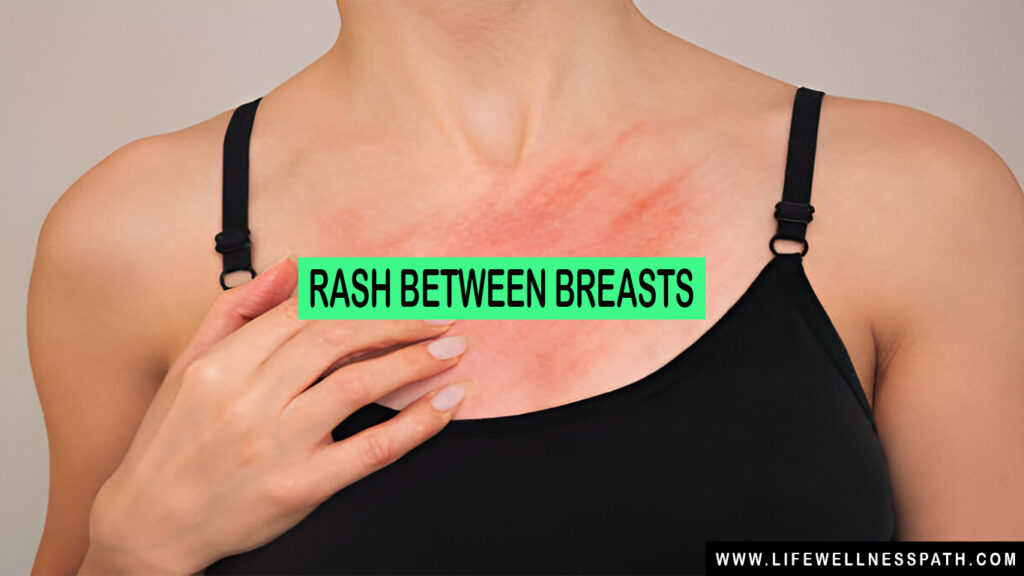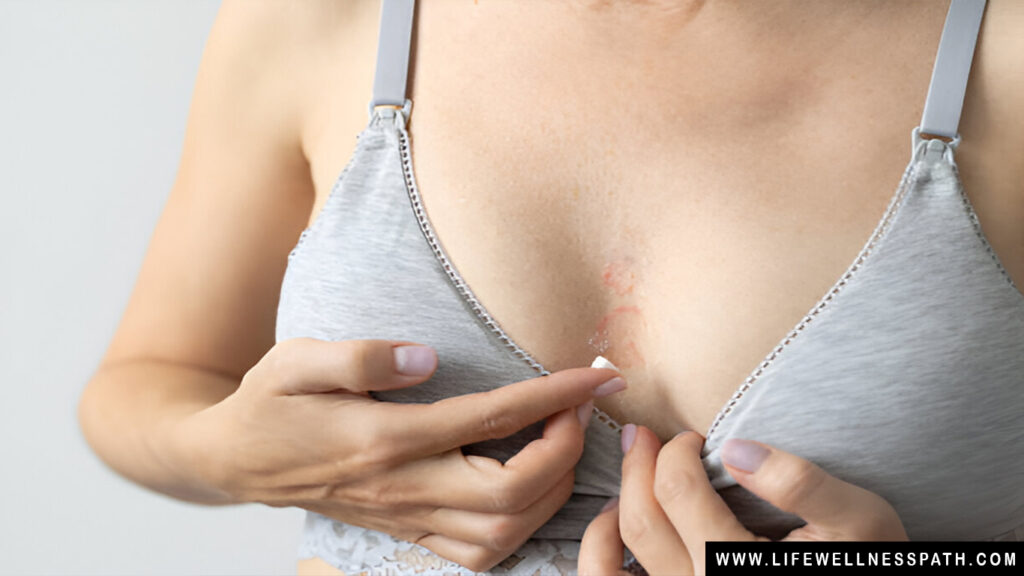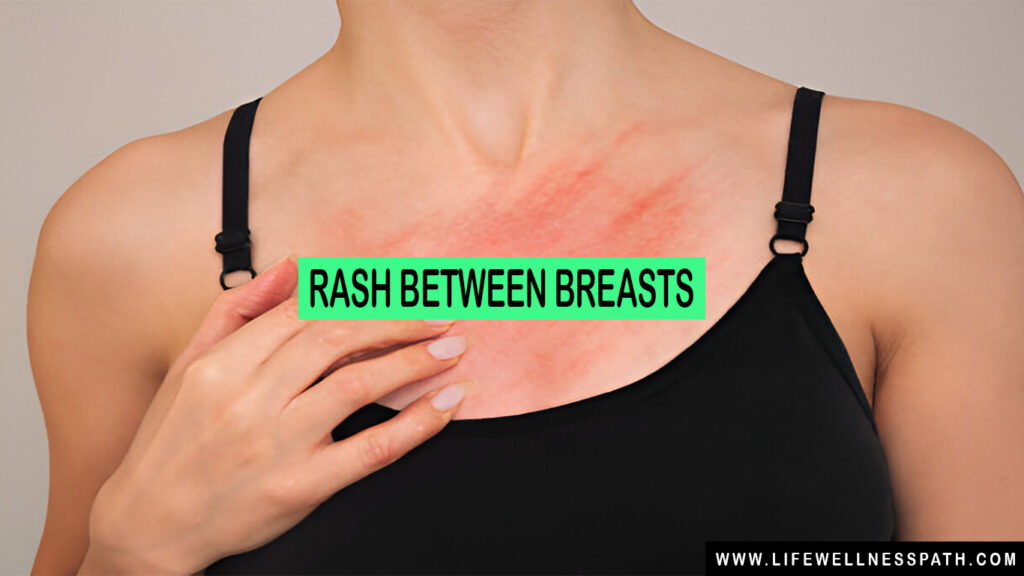Table of Contents
Rashes between the breasts are a common yet often misunderstood issue that can affect anyone. While it may seem like a minor nuisance, this type of skin irritation can cause discomfort and even lead to more serious skin problems if left untreated. In this guide, we’ll explore the causes, symptoms, and best remedies for dealing with a rash between the breasts. Plus, we’ll look at prevention tips to keep your skin feeling fresh, healthy, and irritation-free.
What Exactly Is a Rash Between Breasts?
A rash between breasts is more than just an itch; it’s a form of skin irritation that can come in many forms. From redness and bumps to severe itching and even pain, these rashes can disrupt daily life, making it hard to feel comfortable in your own skin.
Rashes in this area can vary significantly, depending on the root cause. Some people experience mild symptoms, while others may face severe discomfort that requires medical attention. Knowing what to look for can help you manage and prevent this issue from recurring.

Common Causes of Rash Between Breasts
When it comes to rashes between the breasts, there’s no one-size-fits-all cause. Many factors can contribute to this uncomfortable condition, and understanding them is key to finding relief. Common causes include:
- Heat and moisture: This area of the body tends to trap sweat and moisture, especially during hot weather or physical activity.
- Allergies: Reaction to skincare products, fabrics, or laundry detergents can lead to irritation.
- Fungal infections: These are common in warm, moist areas and can cause a painful, itchy rash.
By recognizing these common culprits, you’re one step closer to preventing rashes and keeping your skin comfortable.
Signs and Symptoms of Rash Between Breasts
The symptoms of a rash between breasts can vary but often include redness, itching, swelling, and small red bumps. In some cases, the skin may peel, crack, or feel especially sensitive to touch.
It’s important to pay attention to these symptoms early on, as a mild rash can sometimes worsen if ignored. If you’re noticing any of these signs, it’s best to address them as soon as possible to prevent further irritation.
Why Moisture Management Is Key
Moisture can quickly turn into a breeding ground for bacteria and fungi, which makes managing it crucial for preventing rashes. The space between the breasts tends to trap sweat, especially during exercise or in warm weather.
One effective way to reduce moisture is by wearing breathable fabrics, particularly during activities that make you sweat. Additionally, using absorbent powders or anti-chafing products can make a huge difference in keeping the area dry.
Understanding Heat Rash Between Breasts
Heat rash is a common type of rash that appears when sweat gets trapped under the skin, usually in areas where skin folds. This condition is more likely during hot, humid months when the body struggles to cool itself.
To reduce the risk of heat rash, it’s helpful to dress in light, breathable clothing and keep the skin cool. If you notice small, itchy red bumps, it may be time to adjust your wardrobe and take extra steps to stay dry.
How Fungal Infections Contribute to Rash Between Breasts
One of the most common causes of rashes between the breasts is fungal infection, specifically caused by Candida, a type of yeast. This yeast thrives in warm, moist environments, making the area between the breasts a prime spot.
A fungal infection can be particularly uncomfortable and may require antifungal creams or powders for relief. Ensuring the area is kept dry and clean can help prevent Candida from growing, reducing your risk of infection.
Could an Allergy Be Causing Your Rash?
If you’ve recently switched to a new soap, lotion, or laundry detergent, an allergic reaction may be to blame. Allergic reactions often show up as red, itchy, and sometimes even painful rashes.
To determine if an allergy is the cause, try eliminating recently introduced products. Opt for hypoallergenic options, especially for products that will come into contact with the skin in sensitive areas like between the breasts.
Chafing and Friction: A Frequent Culprit
Sometimes, the culprit behind a rash is as simple as friction. Chafing can happen when skin rubs against itself or clothing, especially in tight-fitting bras or tops. This friction can lead to redness, soreness, and a rash that makes wearing certain clothes uncomfortable.
To combat chafing, choose bras with soft, breathable fabrics and avoid overly tight clothing that can irritate sensitive skin. Anti-chafing balms are also helpful in reducing friction, especially if you’re planning to engage in physical activity.
Hormonal Changes and Skin Sensitivity
Did you know that hormonal changes can make your skin more sensitive? Hormones can fluctuate due to factors like pregnancy, menopause, or monthly cycles, and these changes can make the skin more prone to irritation and rashes.
During these times, it’s wise to be extra gentle with your skin and to avoid any new or potentially irritating products. Keeping the area dry and clean can help prevent a rash from forming during these sensitive periods.
Preventing Rashes: Your Daily Routine
Prevention is always better than cure! Developing a daily routine that prioritizes skin care and moisture management is key. This means washing with gentle cleansers, thoroughly drying the area, and applying any necessary anti-chafing products before getting dressed.
Creating a routine that works for you will make a significant difference in preventing future rashes and keeping the area comfortable, even during warmer months.
Choosing the Right Fabrics to Prevent Irritation
Wearing the right fabrics is essential to preventing rashes between the breasts. Synthetic materials can trap sweat and moisture, which can lead to irritation, especially in warmer climates. On the other hand, natural fibers like cotton and linen are breathable, helping to wick away moisture and keep the skin cool.
Look for bras and tops made from these breathable materials. You’ll find that they help keep you comfortable, especially if you’re prone to sweating. For extra protection, consider layering with a moisture-wicking undershirt to create a barrier that keeps your skin dry.
Finding the Perfect Bra for Rash Prevention
The right bra can make all the difference in preventing a rash. A well-fitted bra provides support, reduces skin-to-skin friction, and prevents excess moisture buildup. It’s also a good idea to choose bras made from moisture-wicking materials to help keep the area dry.
If you have sensitive skin, avoid bras with rough seams or lace that can irritate the skin further. Additionally, consider taking breaks from underwire bras, which can dig into the skin and increase the risk of irritation.
Simple Home Remedies to Soothe a Rash Between Breasts
When dealing with a rash between the breasts, home remedies can offer quick relief. One of the most popular is applying aloe vera gel, which has natural anti-inflammatory properties that reduce redness and soothe irritation.
Coconut oil is another great option because it’s both antibacterial and moisturizing, creating a barrier that helps protect the skin while it heals. For added comfort, try cooling the area with a cold compress or ice pack wrapped in a soft cloth. This can help reduce itching and provide relief from the discomfort.
Over-the-Counter Products That Can Help
If home remedies aren’t enough, over-the-counter (OTC) treatments are readily available and can be effective in treating mild to moderate rashes. Calamine lotion is a popular choice for soothing itching and drying out the rash. Hydrocortisone cream, a mild steroid, can also help to reduce inflammation and itching.
Antifungal creams like clotrimazole are especially useful if the rash is caused by a fungal infection. Be sure to follow the instructions on the package for best results, and avoid using any product that seems to worsen the irritation.
Using Antifungal Creams for Fungal Rashes
For fungal-related rashes, like those caused by yeast infections, antifungal creams are often necessary to clear up the irritation. Products containing miconazole or clotrimazole are designed to eliminate the fungal growth and provide quick relief from itching and discomfort.
Apply the cream as directed, usually twice a day, and keep the area clean and dry. Remember that it’s essential to continue treatment for a few days after the rash clears to prevent recurrence.
Knowing When to Seek Medical Attention
Sometimes, a rash between the breasts requires more than just home care. If you notice that the rash is spreading, becoming painful, or developing blisters, it may be time to see a healthcare provider. Persistent rashes could indicate underlying issues, such as bacterial infections or skin conditions like eczema.
Your doctor may prescribe a stronger medication or recommend a specialized skincare routine. Don’t hesitate to seek help if the rash is interfering with your quality of life or causing significant discomfort.
Building a Skincare Routine for Rash Prevention
Your skincare routine can be a major factor in preventing rashes. Start with a gentle, fragrance-free cleanser to avoid irritating sensitive skin, followed by a pat-dry technique instead of vigorous rubbing, which can lead to irritation.
Once the skin is dry, apply a lightweight moisturizer to keep it hydrated and resilient. Adding a thin layer of barrier cream, like a zinc oxide ointment, can also help protect the area from friction and moisture buildup.
Reducing Sweat and Moisture Accumulation
Excess sweat can quickly lead to a rash between the breasts, so reducing moisture is key. Start by wearing loose, breathable clothing, especially if you’re in a warm or humid environment. Using antiperspirant powder or a moisture-wicking body powder can also help to keep the area dry.
If you’re working out, consider using sweat-absorbing pads that fit comfortably in your bra. Taking a moment to clean and dry the area immediately after exercise can also prevent sweat buildup that might lead to irritation.
The Role of Diet in Skin Health
Your diet can impact your skin’s health, including its susceptibility to rashes. Foods rich in antioxidants, like berries, leafy greens, and nuts, can support skin health and reduce inflammation. Omega-3 fatty acids, found in fish and flaxseed, can also help to keep your skin resilient and reduce redness.
Drinking plenty of water is another essential step in maintaining skin health. Staying hydrated helps flush toxins from the body, which can improve overall skin clarity and reduce the likelihood of inflammation.
Tips for Managing Rashes During Exercise
Exercise can increase the likelihood of rashes due to heat and sweat buildup, but you don’t have to give up your workout! Choose moisture-wicking clothing, and opt for a sports bra that fits well but isn’t too tight. Before your workout, applying a thin layer of anti-chafing balm can help reduce friction.
After exercising, rinse off as soon as possible to remove sweat and bacteria that can lead to rashes. Applying a light layer of soothing aloe vera gel post-workout can also help to calm any irritation that may arise.
Pregnancy and Rashes: Unique Care Tips
Hormonal changes during pregnancy can make the skin more sensitive and prone to rashes. Additionally, increased body temperature and changes in breast size can create friction and irritation. Choosing a comfortable, supportive maternity bra is essential during this time.
Avoid harsh skincare products and stick to gentle, natural remedies for relief. Applying a thin layer of coconut oil or shea butter can help keep the skin soft and protected without causing irritation.
Caring for the Skin Post-Treatment
After a rash has healed, it’s important to care for the area to prevent recurrence. Continue using gentle cleansers and avoid introducing any new products that could irritate the skin. Keeping the area dry and using powder or anti-chafing cream can help maintain skin health.
Exfoliating once a week with a gentle scrub can also help remove dead skin cells and prevent clogged pores, reducing the risk of future rashes. Remember that consistency is key in skincare, especially in sensitive areas.
Myths and Facts About Rash Between Breasts
There’s a lot of misinformation surrounding rashes, and understanding the facts can help you take better care of your skin. One common myth is that only people with larger breasts experience these rashes—this is not true, as rashes can affect people of any size.
Another misconception is that rashes only happen due to poor hygiene. While hygiene is a factor, other causes, such as allergies, hormone changes, and fabric choice, can contribute. Clearing up these myths helps you approach rashes with accurate knowledge and effective solutions.

The Psychological Impact of Dealing with a Rash
Experiencing a rash between the breasts can impact self-confidence, especially if it’s a recurring issue. Many people feel embarrassed or self-conscious, but it’s essential to remember that skin issues are common and treatable.
Finding support through skincare routines, effective treatments, and even online communities can make a big difference. Focusing on self-care and taking proactive steps can help reduce the emotional toll of dealing with skin issues.
Conclusion
Understanding the causes and treatments for a rash between the breasts can help you take control of your skin health. With preventive steps, the right products, and a bit of patience, you can keep your skin comfortable, healthy, and rash-free. Remember to listen to your skin’s needs and consult a healthcare provider if you notice symptoms that don’t improve with at-home care.
faq’s about: Rash Between Breasts
1. What cream is good for rash between breasts?
- Answer: For rashes between the breasts, over-the-counter hydrocortisone cream or antifungal lotions may be powerful. If the rash persists, seek advice from a dermatologist for stronger topical treatments.
2. What is the pores and skin disease between your breasts?
- Answer: Skin diseases along with eczema, fungal infections like candida, or intertrigo can arise among the breasts due to friction and moisture buildup.
3. What is a rash between the breasts with cancer?
- Answer: A rash among the breasts can once in a while be a symptom of inflammatory breast most cancers, even though that is uncommon. If followed through swelling, redness, or ache, consult a physician right away for evaluation.
4. How do I remove intertrigo under my breasts?
- Answer: To deal with intertrigo, hold the place dry and smooth. Use antifungal lotions or powders and keep away from tight apparel. For persistent instances, a medical doctor might also recommend medicated creams or ointments.
5. Can a rash between the breasts be a sign of an allergic reaction?
- Answer: Yes, rashes can result from allergies to fragrances, lotions, or fabric in garb. Identifying and avoiding the allergen is key to prevention.
6. How can I prevent rashes between my breasts?
- Answer: To prevent rashes, preserve the area easy and dry, wear breathable fabric, and avoid tight-becoming clothing. Regular use of talcum powder can help lessen friction and moisture.
7. Is intertrigo a critical condition?
- Answer: Intertrigo is usually no longer extreme, however if left untreated, it may cause bacterial infections. It’s critical to deal with it directly with antifungal creams and keep proper hygiene.
8. What reasons rashes among the breasts?
- Answer: Common reasons consist of friction, sweat, terrible hygiene, fungal infections, or allergic reactions to merchandise. Keeping the area dry and the usage of suitable creams can help alleviate signs and symptoms.
9. Can a rash among the breasts be a fungal infection?
- Answer: Yes, fungal infections like candidiasis are not unusual in regions in which pores and skin rubs collectively, including underneath the breasts. Antifungal remedies can help manage this.
10. How do I understand if my rash is fungal or allergic?
- Answer: Fungal rashes are frequently red, itchy, and might appear in heat, wet areas. Allergic reactions can be observed by using swelling or a burning sensation. If doubtful, seek advice from a dermatologist.
11. Should I see a health practitioner if I actually have a rash among my breasts?
- Answer: If the rash persists, causes ache, or is observed by using different signs and symptoms like fever or swelling, it’s a terrific idea to seek advice from a healthcare issuer.
12. Is a rash between the breasts always because of sweat?
- Answer: While sweat is a not unusual cause, a rash also can be due to friction, fungal infections, or hypersensitive reactions. Keep the region dry and clean to decrease infection.
13. Can sporting bras reason rashes between my breasts?
- Answer: Yes, bras which can be too tight or made of non-breathable fabric can purpose chafing or hypersensitive reactions, main to rashes. Choose well-fitting, breathable bras to lessen inflammation.
14. How long does it take for a rash among the breasts to heal?
- Answer: Healing time depends on the purpose of the rash. Mild rashes can heal in some days with right treatment, whilst infections or extra severe rashes may take longer.
15. Can a rash between the breasts be a sign of contamination?
- Answer: Yes, if the rash is pink, swollen, painful, or has pus, it can indicate a bacterial infection. Seek scientific recommendation for appropriate remedy.
16. What over-the-counter remedies paintings for rashes between breasts?
- Answer: Over-the-counter treatments which include hydrocortisone cream for inflammation, antifungal creams for fungal infections, or calamine lotion for itchiness can be effective.
17. Is it secure to use infant powder to treat rashes between breasts?
- Answer: Yes, infant powder can help absorb moisture and decrease friction, but it’s important to use it sparingly. Ensure the place is smooth and dry before software.
18. Can hormonal adjustments reason rashes between the breasts?
- Answer: Yes, hormonal fluctuations, especially in the course of being pregnant or menopause, can reason pores and skin adjustments, inclusive of rashes because of elevated sweating or skin sensitivity.
19. What is the fine manner to keep the skin among my breasts dry?
- Answer: Regularly clean the location with mild cleaning soap and water, pat it dry with a gentle towel, and use an absorbent powder like talc to keep it dry all through the day.
20. Can terrible hygiene reason a rash among the breasts?
- Answer: Yes, negative hygiene can result in sweat buildup, bacteria, and fungal boom, which could motive rashes. Regular cleansing and drying of the area can assist prevent this.
21. Are there any domestic treatments for a rash among breasts?
- Answer: Some domestic treatments consist of applying aloe vera gel, coconut oil, or chamomile tea bags to soothe angry skin. Always do a patch check first to make sure you don’t have an allergy.
22. Can a rash between the breasts be a signal of eczema?
- Answer: Yes, eczema can reason purple, inflamed, and itchy rashes. If eczema is suspected, it’s essential to apply mild, fragrance-loose skin care merchandise and consult a dermatologist for treatment alternatives.
23. What garb substances ought to I avoid if I actually have a rash between my breasts?
- Answer: Avoid tight or synthetic fabrics like polyester, as they could trap moisture and cause friction. opt for cotton or moisture-wicking fabric to hold the place cool and dry.
24. How can I tell if my rash is because of a contamination or infection?
- Answer: Infections regularly purpose swelling, redness, heat, and discharge. Irritations from friction or allergens are normally localized and might purpose moderate redness and itchiness.
25. Can weight advantage contribute to rashes among the breasts?
- Answer: Yes, weight advantage can result in extended sweating and pores and skin folds, that may purpose friction and rashes. Keeping the vicinity dry and the usage of the right skin care can help.
26. Can a rash between the breasts be a sign of breast most cancers?
- Answer: A rash on my own is not often a signal of breast cancer. However, if the rash is continual, painful, or observed by means of modifications in breast form or size, it’s important to seek advice from a healthcare issuer for assessment.
27. What meals have to I avoid to lessen rashes among my breasts?
- Answer: While no particular ingredients immediately purpose rashes, some people might also revel in flare-U.S Due to food allergic reactions. It’s high-quality to avoid common allergens like dairy, gluten, or nuts when you have sensitivities.
28. How do I save you fungal infections below my breasts?
- Answer: Keeping the vicinity dry and easy is key. Use antifungal powders or creams in case you are prone to infections. Wearing unfastened, breathable apparel also can help.
29. Can a rash among the breasts be due to pressure?
- Answer: Yes, stress can trigger skin reactions, which include rashes. Reducing pressure through relaxation techniques and skin care can assist manage signs.
30. When have to I see a medical doctor for a rash among my breasts?
- Answer: If the rash is severe, painful, doesn’t improve with remedy, or is observed by way of other signs like fever or pus, it’s time to consult a medical doctor for a right prognosis and treatment plan.







